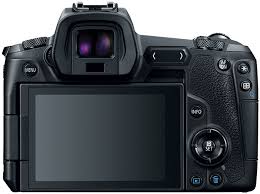Canon EOS R and RF Mount - Chasing The Alpha Again.
Note - My only association with Canon is one of owning their SLR / DSLR cameras and lenses for over 25 years. I have no interest in video so there are no references to it made. All views expressed are my own.
Introduction
The last few weeks have seen the much anticipated launch of a full frame mirrorless camera from Canon which incorporated a new RF mount. Recent years have seen their competitors develop full frame and medium format mirrorless mounts and technology to bring exceptionally performing cameras to market. In the full frame space, Sony launched the FE mount in Oct. 2013 as the foundation for its range of mirrorless cameras (notably the A9 and A7III(R) ) and a growing line up of quality lenses. While in medium format Fuji and Hasselblad announced mirrorless cameras and associated lenses in 2016. So, as a long-term Canon user I was keen to see how they would respond to such competitive threats during a recent visit to Photokina, Cologne. As I'll explain later its not the first time Canon has been slow to react.
Canon at Photokina
Canon made a big, bold corporate statement at Photokina, their presence was huge and probably 4 times bigger than any Canon 'stand' I had seen before. Giant 8K screens showcased panoramic images; they were constant reminders of their pedigree as well as an extensive display of cameras/lenses/printers. They also had a dedicated CPS lounge where members could listen to talks and get hands on with all the gear - it was excellent. But peel off the veneer of such lavish PR and did it have any substance? Well, yes........ to a degree!
Camera Body - The EOS R
In the hand the EOS R feels similar to a DSLR - the grip is much better than the poor design of the Sony bodies which I have always thought felt like a toy. It's not perfect, but the addition of a battery grip (which I didn't try) will make it feel even better.
The camera itself is more of a mirrorless hybrid between a 6D and 5DMKIV. As such it is not something I'd consider (you may be different). It lacks the resolution of my 5DsR and the speed of a 1Dx and even the 5D MKIV. One card slot should be a non-starter for a professional user and anyone who values their work. I dislike electronic viewfinders and still haven't tried one that I like; the EOS R was no different. The new Mfn bar is a clever idea but I kept hitting it with my thumb setting off whatever setting it was configured to deliver. I ended up disabling it.
There was no joystick which to my mind is a poor omission - muscle memory is key to using cameras and my thumb wanted to go to the area where the joystick should have been. The AF points can be moved by using the rear LCD screen but doing that while looking through the viewfinder is pointless to me. The sensor is believed to be derived from the 5D MKIV which is 4 years old so no incorporation of BSI sensor nor IBIS (in body Image Stabilisation). All in all it's a mid-range camera and very much a first offering.
All that will change as iterations come through, history shows us that and improved technology will deliver it. Consider the development of Canon digital cameras over the last 20 years or so. In 1995 Canon launched the EOS DCS1 costing £22K (1995 yen to £ x rates), yes £22K - that's over £40K today adjusting for inflation. It had 6MP and a 340MB internal hard drive! Roll forward 10 years to 2005 and the EOS 5D, c. £2.5k 12.8MP Digic II processor and portable memory cards. Then to 2016 and the EOS 1DX II - £5K 20MP 2 Digic 6+ processors and 14 frames / second, 4K video.
The CPU's have improved dramatically during this time too. For example a Digic 5+ (2 in the 1DX) is 17 x faster than the Digic 4, which is also in the 1DX for metering and subject recognition, yet it is the only processor in the 5D MKII! I don't know for how long Moore's Law will prevail (processor speeds, overall processing power for computers will double every two years.) but future iterations of the EOS R will clearly go well beyond Digic 8 and deliver faster speeds and power.
The point is camera bodies will come and go every few years - they launch at a high price and depreciate rapidly thereafter. Buying one that is right for you rather than having the latest model is a wise strategy; the EOS R is the latest example. Lenses however are a different story.
Lenses and the RF Mount
While camera bodies come and go lens technology tends to progress at a slower pace. The introduction of the RF mount however facilitates a step change in such technology, something we haven't really seen for 30 years when the EF mount replaced the FD (with perhaps the exception of Image Stabilisation in 1995).
Back in the mid-80's Canon lagged behind both Minolta and Nikon in 35mm auto-focus (AF) SLR's. Both had launched true af 35mm slr's 2 to 3 years before Canon in 1985 and 1986. Canon responded with the EOS project (Electro Optical System, named after the Goddess of Dawn in Greek mythology) which included the EF mount. In 1987 the first EF mount camera was launched, the EOS 650, then soon after the EOS 620 (an improvement) and then the EOS 1 two years later. Does all this sound familiar?
It's the future abilities of RF mount lenses that are more interesting than the first camera!
Back in 1987 Canon effectively abandoned all of its FD lenses - while there was a token FD/EF adapter it worked on a limited number of lenses and few were made, consequently EF Mount lenses were released at a rapid rate (14 in 1987 alone). New to Canon adopters like me at the time were fine, I had no legacy kit to consider - but many people did and had no transition options except to sell their entire FD range and buy EF, or go to a competitor. Roll on 30 years and this time I am a legacy (EF) user but thankfully there are options to use EF lenses on the RF mount through adaptors that lose nothing in terms of optical quality and speed. Imagine the uproar if they'd abandoned all the EF lenses!
Technically, the RF mount decreases the flange distance (lens to sensor) from 44mm to 20mm while the diameter remains at 54mm. This reduced flange distance apparently allows more options in lens design such as larger lens elements at the rear of the lens which improves edge sharpness (MTF charts back this up).
Other examples are zoom lenses with greater brightness (wider apertures) across the entire zoom range illustrated by the release of the impressive 28-70 f/2 L USM. (Note no image stabilisation, which given its price of £3K is surprising, but then again perhaps IBIS is coming?)
Auto Focus is also possible through to F/11 even with EF lenses, useful for telephoto users. The RF lenses also incorporate a control ring that allows lens based control of aperture/shutter speed/iso which I found to be a really excellent addition. Electronic communication between the lens and camera also improves (note the increased pins 8 to 12).
The Canon White paper is an insightful read and clearly informs where the mirrorless system is going - download a copy here. This strategic document lays out the future plans for the RF mount and is far more useful than myopic reviews / videos that focus solely on the camera and not the bigger picture. I'd encourage anyone to read it.
What Does It All Mean For The User?
Well just as I was back in the late 80's any new to Canon user can come straight in with the EOS RF. For legacy users like me, things aren't so simple.
We know current EF lenses will work on RF mount cameras through an adaptor so they can be used on FF mirrorless bodies, as and when we buy one. As there isn't any backwards compatibility RF/EF, RF lenses cannot be used on EF mounts - so no point buying an RF lens until you have the body to attach it to. Consequently, the solution seems to point to acquiring a new FF mirrorless body first, when one is released that meets your needs. Once I've got a new body(ies), I know I can use my EF lenses on them until such time as I feel their optical performance has been "significantly" surpassed by the equivalent RF lens.
I expect current full frame EF bodies to be replaced at the next update cycle, while the replacement of some EF lenses could be slower, given the available adaptor and as the telephotos have only just been updated. I can foresee a flagship, sports/action EOS 1Rx type out before the 2020 Olympics in Tokyo (Canon are not going to miss having a world class sports body at their home Olympics). By then the 1DX II will be 4 years old - incidentally the 1DX was 4 years old when it was replaced. By coincidence, it took Canon 2 years to launch the EOS 1 after the EF mount was introduced in 1987. We may see a replacement for the 5Ds(R) before then though, it will be 4 years old in 2019 so an announcement soon wouldn’t surprise me.
Legacy EF super telephotos will I think prevail in the short-medium term with perhaps the exception of 1 RF as a prototype in 2020. As a landscape photographer resolution and dynamic range are fundamentals of the camera body, while lens performance or use at say f/2 is not that relevant but optical characteristics at f/8 / f/11 definitely are. Each lens should be judged on its own merits and a full understanding of how much better the equivalent RF lenses known before a purchase. Remember, diffraction is diffraction regardless of lens or mount! Portrait, wedding, event, studio photographers etc.... will have different considerations to make.
In Conclusion
It is should be no surprise that a mid-range camera was chosen to launch the RF mount, but this isn't new for Canon, they're playing catch up again, just as they were in 1987. The camera bodies are going to evolve just as they have done over the last 20 years but whether the pace of change remains the same is unknown. Moore's Law will no longer apply at some point.
Canon has an excellent reputation around lens design and innovation, their tilt and shift lenses, the 11-24, 200-400 f/4 with build in extender and super telephoto lenses are second to none. They've pitched their mirrorless strategy and future lens design around the RF mount, a strategy they'll deliver. Perhaps the key question is how patient are their loyal customers going to be in waiting for a truly world-class, full frame mirrorless camera that at worst keeps pace with the competition. They were quick off the mark in 1987 chasing Minolta, I expect the same in 2018 with a pro type high resolution body in 2019 and a sports orientated body by 2020.
It is with some irony that Canon (and others) are chasing the Sony Alpha range in the full frame mirrorless market today given it was Sony who purchased part of the Konica / Minolta photo business in 2006. After all it was Minolta who launched the first true autofocus SLR camera in 1985 with the A mount, marketed as Alpha in Japan and Asia.
References - Canon Museum






